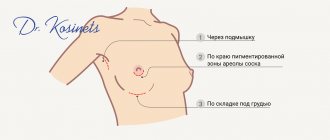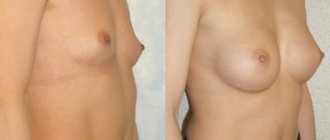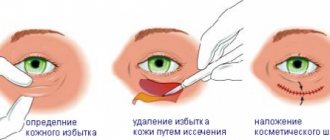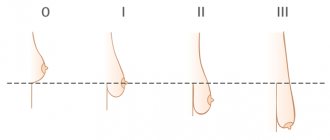For many centuries, the debate about which breast can be considered perfect has not ceased. Men are either delighted with curvy figures, such as Sophia Loren, or admire ladies with miniature busts, like Twiggy, Ali MacGraw and Vanessa Paradis. Each size of women's charms has its fans, who, meanwhile, agree that only high, toned breasts can be considered beautiful.
No man can indifferently pass by a lady with a sexy cleavage peeking out from her deep neckline. Not a single representative of the stronger sex can resist the sight of elastic hemispheres, the ideal outlines of which can be discerned under clothing. Unfortunately, age, childbirth, gravity and other factors affect the shape of the chest in a detrimental way, transforming the “divine apples” into spaniel ears. Fortunately, modern medicine, like a good fairy who knows how to remove the spell of an evil witch, has long learned to perform the reverse transformation using mastopexy.
Mastopexy - what is it?
The described operation is performed mostly on women after childbirth and breastfeeding.
The skin of the mammary glands in such patients is thin, stretched, and only “skin bags” remain from their former forms. The volume of adipose tissue and the mammary gland itself is also minimal. The same picture is observed in women after massive weight loss. The photo shows variations of ptosis (drooping) of the mammary glands. Indications for mastopexy with implants.
Areolar mastopexy with implants. The least voluminous and relatively simple operation is mastopexy with access through the nipple areola and installation of breast implants. In this case, an incision is made around the circumference of the nipple areola, a pocket is prepared for installation of the implant, and the implant is installed. Next, excess skin and fatty tissue are removed, and if necessary, the size of the areola is reduced. The tissue is sutured in layers and the breast is “gathered” around the areola. The technique is used for mild sagging (ptosis) of the mammary glands.
Vertical and T-shaped (anchor) breast lift with endoprosthetics. A more complex operation is a correction that requires a more significant lifting of the mammary gland tissue with a vertical and even a T-shaped (anchor) incision. In this case, the incision is made around the circumference of the nipple areola and vertically downward, with possible extension in the submammary fold (the incisions resemble the shape of a tennis racket or anchor).
The technique is used for significant sagging of the mammary glands (2nd and 3rd degree ptosis). First, the surgeon makes the necessary incisions and prepares the bed for the implant. After the installation of endoprostheses, the breasts are collected around the implants: excess skin and fatty tissue are removed, the areolas are moved to a higher position, and their size is adjusted if necessary. Finally, the tissues are sutured in layers.
Photo of the “anchor” scar
When correcting ptosis of the mammary glands with simultaneous enlargement, round implants are most often used. Since mastopexy involves quite a few incisions, the access used to install the implants is not particularly important. The endoprosthesis, as with breast augmentation, can be installed completely or partially under the pectoralis major muscle.
The operation of a breast lift with simultaneous endoprosthetics is quite difficult to perform, as it requires precise calculations and operational experience from the surgeon. Breast augmentation or breast lift surgery alone is simpler to perform than their combination.
Causes of breast ptosis and indications for surgery
Before talking about mastopexy and what it is, it must be said that the female breast does not consist of muscles (although according to statistics, 5% of the population thinks so), but of milk ducts, glandular, fatty tissue and Cooper's ligaments. Plastic surgeons divide mastoptosis into categories, depending on the location of the nipple-alveolar complex. There are three types of ptosis:
- true - the nipple is lowered below the inframammary fold;
- false (or pseudoptosis) - the nipple is in a normal position, and only the lower parts of the breast sag;
- glandular - the gland has a normal volume, but sags very much, the nipple-alveolar complex is located above the fold.
The degree of mastoptosis is determined using the Renault scale:
- I degree – the nipple descends to the level of the inframammary fold;
- II degree – the nipple-alveolar complex is located below the fold, but above the contour of the mammary gland;
- III – the nipple-alveolar complex “looks” down.
Sagging of female breasts occurs under the influence of many factors, among which a special role is played by a hereditary predisposition to ptosis of the mammary glands, pregnancy, long-term feeding, age, frequent fluctuations in body weight and the influence of gravity. Scientists have found that mastoptosis is more pronounced in women who abuse alcohol and smoke, so preventing its development consists of giving up alcohol and tobacco.
Indications for mastopexy:
- asymmetry;
- breast drooping;
- stretched, inelastic skin in the gland area;
- drooping of the nipples below the inframammary fold;
- overstretching of skin tissue, which entails the formation of stretch marks (stretch marks);
- elongated areolas
Sign up for a free consultation:
Breast lift surgery with immediate installation of implants is a painful procedure. Pain in the chest area persists for a week. After 7-10 days, the pain subsides, after 14 days you can return to work, provided that your work does not involve any physical activity.
During the month, you must be careful: be sure to wear compression garments, do not lift more than 2 kg, and limit any physical activity. Follow all your doctor’s instructions to avoid possible complications (implant displacement or suture dehiscence).
After breast lifting surgery with simultaneous enlargement, the patient stays in the hospital for 2-3 days. During this time, dressings and cosmetic procedures are carried out aimed at maintaining the body and speeding recovery. On the third day, the drains, which should have been installed immediately after the operation, are removed in order to avoid the development of a hematoma in the early postoperative period.
Ultrasound or mammography is recommended to be performed once a year after breast lift with simultaneous installation of endoprostheses. As a rule, all scarring processes and recovery after this manipulation are completed within a year after the operation.
It should also be noted that the mammary glands after a breast lift with one-stage enlargement seem larger than planned. This is due to swelling, which will go away gradually. As the swelling goes away, the breasts should also drop a little and take on a more natural appearance.
Scars after mastopexy with implants are actually not so obvious. Any scar begins to turn white 6 months after surgery, turning from a red line to a white line. If the tissues were distributed without tension, the scar will be thin and neat. However, it would still be a good idea to use special means that prevent scar hypertrophy (gels, patches that are used for 2 months after healing).
Contraindications are:
- pregnancy,
- lactation,
- exacerbation of chronic diseases (including herpes),
- oncological diseases.
Pregnancy should be planned at least a year later. In this case, observation by a mammologist is recommended.
Breast lifting with one-stage enlargement is recommended to be carried out no less than a year after childbirth and no less than 8 months after the cessation of lactation.
List and validity period of tests.
Complications
Breast lift is a fairly extensive operation, accompanied by a large wound surface and long scars. All this increases the likelihood of developing local complications.
The following types of complications may develop after mastopexy:
- Early postoperative - hematoma, wound suppuration, wound dehiscence, marginal necrosis of skin flaps, malnutrition of the nipple.
- Late postoperative - deformation of the gland, secondary ptosis of the gland with loss of volume, deformation of the nipple or areola.
Early postoperative complications.
Early postoperative complications
Hematoma occurs no more often than in 1.5-2% of cases, most often occurring on the first day after surgery. Treatment consists of evacuation (removal) of the hematoma. With timely treatment it does not lead to significant consequences. Local infection can be a consequence of a hematoma or as an independent phenomenon. Antibiotics are prescribed to prevent it. Dehiscence of wound edges can occur either as a result of technical errors in suturing, or due to disruption of the healing processes due to insufficient immunity. Necrosis of the nipple or areola occurs rarely (no more than 1% of cases); the main reason is errors in surgical technique.
Get a discount on surgery:
There are many indications for such intervention, but they are all purely aesthetic in nature.
Small breast size from birth. One of the main reasons for complexes in women.
Asymmetry of the mammary glands. Surgery is recommended when the difference between them is one or two sizes.
Previous surgical interventions in the chest area. Breast cancer often requires surgical treatment. In this case, they can either excise part of the mammary gland or remove it completely. It is mammoplasty that allows you to restore an attractive appearance and self-confidence after a complex disease.
Mastoptosis (prolapse of the mammary glands). The main causes of this condition are breastfeeding or natural aging of the body. But every woman in any position and at any age wants to look attractive.
Professional requirements. Actresses, models, singers. To be successful, their body shapes and contours must fit a certain image.
Sometimes situations arise in which the patient wants her breasts to be enlarged, but the doctor does not see good reasons for this. In this case, he will always tactfully explain why she should not change her forms or offer alternative options.
Any surgical intervention, including plastic surgery, may have a number of limitations. When is breast augmentation not recommended:
- age under 18 years;
- oncological processes in the body, including in the mammary glands;
- period of pregnancy and lactation;
- chronic diseases in the acute stage;
- bleeding disorders;
- endocrine pathologies.
All possible contraindications are identified by the doctor at the initial consultation. And if you still have to refuse endoprosthetics, an experienced specialist will definitely offer an alternative solution to the problem without surgical intervention.
Preparation for endoprosthetics involves an examination by a doctor, taking an anamnesis, and undergoing a series of examinations:
- clinical blood and urine tests,
- fluorography,
- Ultrasound of the mammary glands,
- ECG.
You can learn more about preoperative preparation for breast augmentation by consulting a doctor. After the examination, the patient, under the guidance of a plastic surgeon, can decide on the size of the implants and the manufacturer.
Two weeks before surgery, you must stop smoking and drinking alcohol, as bad habits can cause complications. For example, nicotine can slow down the healing process of a surgical wound, and alcohol can provoke surges in blood pressure and worsen blood clotting.
The big advantage of mastopexy is that it can be performed in combination with breast augmentation using implants. Implants will add volume, which will improve the aesthetic picture. Often, the patient simply does not have enough volume in the upper part of the mammary gland, which is why the breasts look sagging. That is why, in such situations, mastopexy with implants is an excellent solution to the problem.
Breast lifting and augmentation have minimal risk of possible complications. Unpleasant consequences can be avoided with the correctly selected method of an experienced surgeon and compliance with all his instructions in the postoperative period. It is also worth noting that breast lift and breast augmentation do not affect the development of mammary gland diseases.
Classic mastopexy surgery with endoprosthetics includes removal of excess stretched skin and subcutaneous tissue, formation of a higher breast contour, fixation of the breast at the desired level and installation of implants. Scars after complete postoperative recovery are practically invisible, largely due to their location.
The breast lift method is determined by the surgeon, depending on the degree of breast ptosis of a particular patient.
- breast lift with an incision around the areola (for slight prolapse);
- breast lift with a vertical incision (the mammary gland is larger, there is significant prolapse);
- lift with horizontal and vertical incisions (to eliminate large breast deformities during breast reduction surgery).
Access for an implant during breast lift and augmentation is one-step, usually through the areola area.
In general, breast replacement with mastopexy is a fairly easily tolerated operation. Of course, for the first time after breast lift and augmentation, discomfort in the operated area is possible. However, it passes quickly. In almost every case, drainage is installed to drain blood and eliminate swelling. It is removed the very next day.
Possible complications and contraindications for the procedure
Before lifting sagging breasts using mastopexy, you need to familiarize yourself with the list of contraindications for its implementation:
- age under 18 years;
- overweight;
- autoimmune process in the body;
- reduced immunity;
- bleeding disorders;
- diabetes;
- disruption of the endocrine system;
- oncology.
Possible complications:
- excessive pain in the mammary glands;
- hematomas;
- pronounced asymmetry;
- secondary prolapse;
- formation of rough scars;
- temporary loss of nipple sensation;
- infection or suppuration of the edges of the surgical wound.
For what reasons can surgery be prescribed?
Beauty does not always push women to undergo surgical interventions.
There are a number of reasons why breast lift surgery may be indicated, including:
- congenital anatomical abnormalities;
- the birth of a child and prolonged breastfeeding;
- changes that occur in the female body under the influence of age;
- reduction in total body weight in a short period of time. Occurs mainly among those who like to go on strict diets;
- birth defects. These include asymmetry of the mammary glands.
Prices for services
The price for a breast lift with augmentation in our clinic consists of several components: breast lift (240,000 rubles), installation of implants - 180,000 - 200,000 (depending on the category of operation), implants from 60 to 90 thousand, anesthesia - 27,000, a day in hospital - 6500, compression stockings and bust 8500 rubles.
| Name | Price |
| Primary appointment (examination, consultation) with a plastic surgeon | FOR FREE |
| Surgical correction of breast ptosis (both sides) category 1 | 250,000 rub. |
| Breast lift along the areola | 100,000 rub. |
You can sign up for a free consultation with our surgeons by calling the clinic: 7 (495) 137-51-81
The most important advantage of the procedure is the absence of insertion of a foreign object into the chest. Thereby:
- the risk of complications after surgery is reduced;
- the risk of allergies is minimized;
- any degree of breast sagging is eliminated.
These arguments indicate the safety and reliability of mastopexy.
Representatives of the fairer sex over the age of 18 resort to such surgical intervention.
There are some conditions that cannot be neglected:
- small breast size requires the introduction of implants, otherwise the operation is pointless;
- if there are plans for future motherhood, such plastic surgery should be postponed;
- Before lifting, body weight must be stabilized, otherwise a possible decrease in weight will subsequently lead to new deformities.
But at the same time, it does not affect these processes in any way, because all functions remain unchanged.
Among the disadvantages of the procedure, it is worth noting the partial result, which is due to the uselessness of its implementation on a large bust and severe ptosis.
In rare cases, there is a loss of nipple sensitivity and feeding function. Also, due to tissue tension, the resulting scar can stretch greatly, which will significantly spoil the result.
Operation price
It is important to know that a double operation will cost much less than two separate ones.
The price of breast replacement with mastopexy is around 300 thousand rubles. Separately, endoprosthetics costs about the same. The price for mastopexy is around 100 thousand rubles.
Naturally, the cost is different everywhere. It depends on the prestige of the clinic, the reputation of the doctor and the type of implants.
So, endoprosthetics with mastopexy is a pretty good operation. It allows you not only to enlarge your bust, but also to make it more toned. In addition, double surgery is much cheaper. In the future, it will not affect breastfeeding in any way, which is an obvious advantage for women planning to give birth.
Rehabilitation
A day later, the patient is discharged and prescribed wearing special compression garments for a month, taking painkillers and antihistamines. It is advisable to ask someone close to you to look after the patient, since many actions (hanging up laundry, picking up a child) will seem difficult.
The first results will be visible when the swelling finally subsides and the bruising disappears. The rehabilitation period lasts longer than during initial treatment and is about 3-4 months. At this time, you cannot take hot baths, showers, go to the sauna, bathhouse, or sunbathe. Intense physical activity is prohibited until complete recovery.
Popular questions
Is it possible to combine implant replacement with a lift?
Yes. In such cases, surgery immediately solves several problems: ptosis, ugly shape and small size. In some cases, such a combination is even indicated, otherwise flattening of the mammary glands is possible without the installation of endoprostheses.
How many times can implants be changed?
Implants can be changed, there is no need to be afraid of it. If the patient has a medical reason, an unsuccessful first operation, or a desire to change the size, then the implant can be replaced. But it is worth remembering that the more often the body undergoes surgical intervention, the higher the likelihood of scarring of the cosmetic seam. This is especially true for women prone to skin scarring.
After the operation, the patient is accompanied by already familiar symptoms and pain in the form of tingling, heaviness in the chest and numbness.
All advice and instructions remain identical as with primary breast augmentation.
What you need to know about the pros and cons of a breast lift?
If we talk about the pros and cons of breast lift with implants, everything is very ambiguous. Let's take a closer look.
In most cases, mammoplasty is performed without any indications, with the exception of the cases described above, and the main positive feature will be the increased self-esteem of the fair sex.
The next advantage is the tightened breasts and the restoration of their appearance if surgery has been performed to remove the mammary gland. This operation is performed if cancer has been detected. As a result, the woman receives severe psychological trauma. This is where implant placement can help.
Not every woman knows that breasts cannot have the ideal shape and size. Both mammary glands have some differences in these characteristics. It is considered normal if the difference reaches several sizes. It is very difficult to come to terms with this state of affairs, conditioned by nature itself. That is why installing an implant with an adjustable volume is a completely acceptable way out of this situation.
Achieving an aesthetic result is also an undoubted advantage when performing mastopexy with implants. If there is ptosis or pseudoptosis, they tighten the skin and increase the volume that could have disappeared during breastfeeding.
Minuses
The disadvantages include the following factors, which appear in the form of complications associated with surgical intervention and temporary limitation of work activity.
Along with the already listed disadvantages, we can list a few more negative aspects after breast augmentation, for example, the appearance of scars. This nuisance occurs when incisions are made during surgery. It doesn’t matter how exactly the surgical intervention took place, the sutures remain visible. After some time they become thinner and lighter. However, in some representatives of the fair sex, the scar may begin to expand and become rougher.
Difficulties in performing mammography are also significant disadvantages. Lifting the glands leads to complications in identifying possible tumors.
In some cases, damage to the nerve endings can occur and then the sensitivity of the nipple is lost. Here, of course, the risks are minimal, but they still exist.
Loss of ability to breastfeed. Most operations are now carried out in such a way that women can feed their children naturally if necessary. But sometimes damage to the gland ducts occurs, and then breastfeeding becomes impossible.
Modern technologies make it possible to produce very durable implants that undergo many tests, but in some cases the shell is damaged. If the saline implant ruptures, the contents will end up in the body. Fortunately, there is no harm to humans from saline solution.
Features of breast implant replacement
Breast replacement (augmentation mammoplasty) is a surgical operation whose purpose is to increase the size of the mammary glands using endoprostheses. Every woman who turns to a plastic surgeon for help can be sure that this operation will give her breasts a beautiful shape and the skin its former elasticity.
Based on this, there are several types of this operation - periareolar or circular, vertical, anchor (T-shaped incision), dermal and endoscopic.
Each of them involves improving the shape of the bust without endoprosthetics and is prescribed depending on the severity of ptosis.
This type of breast lift is quite complex, which is recommended by specialists for the second degree of ptosis. Technically, it involves removing part of the glandular tissue, which may cause the nipples and areola area to lose some of their sensitivity.
The operation is carried out over a couple of hours, during which the incisions are made quite deep and penetrate into the submammary fold. Another feature is the patient’s mandatory stay in the clinic for about a week.
This happens due to breast swelling and severe pain that requires symptomatic treatment. During the postoperative period for 3 months, the patient is required to wear special compression garments and avoid stress on the chest muscles.
This method is considered one of the most popular, which is used for pseudoptosis, 1st and 2nd degree prolapse and abnormal breast development. A periareolar lift involves making an incision around the perimeter of the areola, thereby removing excess stretched tissue.
After this, the mammary gland is attached to the pectoral muscles using special sutures. Due to the fact that the nerve endings are not damaged, its sensitivity is completely preserved. The surgery is performed under general anesthesia within an hour. The main rehabilitation processes last about a week.
Anchor mastopexy
This species got its name due to a special cut that resembles an anchor or an inverted letter T. It runs along both edges of the areola, connecting into a vertical line.
Next, the surgeon makes branches in different directions along the inframammary ligament. The indication for such mastopexy is pronounced degrees of ptosis, often combined with reduction mammoplasty.
It is this lift that has its own characteristic features. Thanks to the technique, the specialist excises a significant amount of skin and other tissues, which contributes to an excellent result and long-lasting preservation.
Among the disadvantages, it is worth noting significant scars that remain visible after the procedure.
This type of lift is based on an operation to lift sagging breasts as a result of losing weight or breastfeeding. By removing excess folds, the projection of the breast changes and its elasticity improves.
Also, at the request of the patient, the shape of the areola changes. Depending on the degree of prolapse, a joint increase through the introduction of implants is possible. Scars after dermal mastopexy fade over time and become invisible.
An operation such as mastopexy (what it is stated above) leaves behind scars that cause discomfort for many. Therefore, a method was developed whereby the effect of this factor is minimized. Endoscopic lifting occurs through punctures that leave only barely noticeable scars.
The technique of performing this method consists of puncturing the mammary gland, through which fluid is injected to reduce possible bleeding.
Using instruments inserted through an incision under the armpit, the skin is separated from the glandular tissue. A part in the form of a triangle is cut off from the latter. Next, the fabric is pulled up and the edges are sewn. All incisions are closed with sutures.
Don't miss the most popular article in the section:
Breast lift without implants - all methods, methods and procedures. Efficiency, before and after photos.
During this procedure, an implant is inserted into the mammary gland and at the same time a breast lift is performed. Indications are the woman’s very desire to improve her bust, deterioration in her shape after breastfeeding or weight loss, when replacing endoprostheses with new ones.
There are two types of such an operation - one-stage (combined) and sequential (first a lift is performed, then an increase).
To carry out such a surgical intervention, the doctor must have enough experience, and the patient must be prepared for possible cumulative complications after it.
These include insufficient correction of breast prolapse, the occurrence of their asymmetry, displacement of implants, and complete loss of sensitivity of the nipple and breast skin.
In addition to this, the most common problem with one-stage surgery is the appearance of rough and wide scars. For this reason, many surgeons first perform mastopexy and insertion of prostheses in two stages.
- pronounced breast asymmetry;
- dissatisfaction with the size of the inserts, the desire to increase the bust by at least one size;
- wrinkling or folds appearing under the breasts (the so-called double breast effect);
- dissatisfaction with the appearance of the breasts after specific events, for example, pregnancy and lactation, surgery, ptosis due to age-related reasons, sudden weight loss.
Among the medical indications for breast replacement, the most common are the following:
- Gel leakage from silicone inserts. Due to the rupture of the prosthesis, a woman may feel pain in the chest area, and swelling and inflammation usually develop. The damaged prosthesis must be removed as soon as possible.
- Sagging glands (ptosis).
- Synmastia. In simple terms, this is the disappearance of the interbreast space and the fusion of the mammary glands in thin women with thin skin. Implants in such cases are usually always wide.
- Bleeding.
- Inflammation.
- Fibrosis. The implant seems to be overgrown with scar tissue, as a result of which the glands become dense, tight, and the patient experiences severe pain.
- Bad prosthesis. In such cases, the integrity of the silicone capsule is easily damaged, it wrinkles or falls off in places.
- Infection.
It is also important to know that after 10-15 years or more, regardless of the operation, the quality of the silicone and the skill of the surgeon, there will inevitably come a time when the prosthesis will have to be replaced. It will shift or the soft tissue will stretch. There are few contraindications to surgery. These are pregnancy or lactation, infectious diseases in the acute stage, chronic diseases in the acute stage, inflammation, oncology, neoplasms in the breast area.
Variety of types of surgery
The main goal of all types of mastopexy is not to change the size of the mammary glands, but to tighten and restore natural, attractive shapes. The most common methods used in surgery are the following.
A breast lift without scars can be done. The most popular technique is the use of a circular breast lift. Mastopexy is advisable for grade 1 or 2 ptosis and if the breasts are small. An incision is made along half the areola line. It becomes possible to raise the nipple, but not higher than 2 cm. If it is necessary to raise the nipple by more than 2 cm, then another type of circular lift is used - circular. An incision is made along the entire contour of the areola.
The surgical lift lasts approximately an hour. Possible combination with endoprosthetics. After mastopexy, there are no obvious scars and no visible stitches. Since the nerve branches are not affected, the sensitivity of the nipples is not lost.
Vertical mastopexy is considered more difficult, since the incisions have to be made deep. Some of the incisions pass around the nipple along the border of the areola, and the other goes down to the inframammary fold. Then the skin surface is connected using special sutures.
A vertical lift allows you to improve the shape and size of the nipples, eliminates various anatomical features in the structure, and the mammary glands become symmetrical. The disadvantage is that during mastopexy it is necessary to remove not only the stretched skin, but also the glandular part of the tissue. This can lead to partial or complete loss of sensation in the nipples and areola.
Vertical mastopexy is performed only under general anesthesia and lasts on average 2.5 hours. The patient should remain in the clinic for another 5-7 days after making the incisions in a vertical manner. At this time, there is severe swelling in the chest area and painful sensations.
T-shaped mastopexy is another type of plastic bust correction and is recommended for severe ptosis. An anchor breast lift involves incisions in three areas (breast correction with a T-shaped incision): around the nipple, down from the middle of the nipple to the base of the breast and along the inframammary fold.
Visually, the cuts resemble the pattern of an anchor, hence the name of the anchor technique. Plastic surgery is most often performed under general anesthesia.
Since quite large incisions are made during anchor mastopexy, conditions are created to remove stretched tissue and skin. As a result, it is possible to tighten the breasts and give shape. The effect lasts for a long time. The downside is the scars, which will not heal completely.
Endoscopic breast lift causes the least amount of trauma. After it there are almost no traces left. A breast lift is performed using several punctures through which an endoscope is inserted. They remove excess glandular tissue. Prescribed for owners of small breasts, with a small amount of stretched skin.
The endoscopic method of mastopexy is very often performed simultaneously with the insertion of an implant to increase the size of the mammary glands. As a result, the bust will tighten and look attractive.
It is quite possible to evaluate the results of each type of mastopexy in the photo. You can study the condition of breasts that are removed at various intervals after surgery. This will allow you to get a complete picture of the results of the procedure.
Breast lift with mesothreads
Due to the fact that this procedure is positioned as a replacement for surgery, many patients have inflated demands on the final result.
But from a medical point of view, thread lifting has significant limitations.
This is the only way to stop their progression in the coming years. The number of procedures performed after the effect disappears is unlimited.
The skin holds the inserted threads well and over time they become overgrown with connective tissue, which forms a fairly strong frame for the mammary gland. Their number for one breast varies from 7 to 10 pieces, the length of each of them is slightly more than 6 cm.
As reviews from patients who have used a thread lift show, the effect lasts for a long time with small breasts. Many women write that even with a full third bust size, this procedure turns out to be useless.
This is worth considering before choosing this method for lifting your breasts. Others are often satisfied with the results obtained.
There are several types of threads that are used in mammoplasty. They are divided into non-absorbable and biodegradable. The doctor’s choice of their type is influenced by the patient’s age, breast size and the outcome she expects. So, surgeons use the following threads:
- Aptos Light Lift Body, which is made from polylactic acid, has a rough surface for good tissue fixation. Gradually they completely dissolve. The results obtained last for about 2 years.
- Aptos Excellence Body, which are made on the basis of the previous type with the addition of caprolac. It is completely eliminated by the body within a year. Their surface is smooth, but with notches. Their effect also lasts for 2 years.
- Resorblift, which contains polylactic acid. A special feature is their long resorption (9 months). They do not cause allergies or rejection by the woman’s body. The result is very long-lasting – 3 years.
- Aptos Needle - non-absorbable threads. They contain polypropylene. It is used for patients over 40 years of age with a fairly large breast size. The effect is amazing - the bust remains tightened for more than 5 years.
- Gold ones, which were previously used in mammoplasty as the main threads. They wrap around their absorbable counterpart. Over time, they were almost completely abandoned, as they have some serious disadvantages. Firstly, gold threads retain the shape of the mammary gland, but do not tighten it. Secondly, later, with an active lifestyle, they can break and appear on the surface of the skin. Thirdly, if they are present, many cosmetic procedures, especially laser ones, are prohibited.
What are the preparatory stages for the operation?
If there is a need for a breast lift using implants, then first of all you need to consult a surgeon. The specialist will determine how strong the cosmetic problems the woman has, and will also listen to the wishes that the patient may have. The doctor will also be able to tell you which method is best to use in a particular case.
The consultation serves to ensure that the doctor can explain to the woman all the possible consequences of the surgical intervention, what complications may arise, as well as how good the result will be. If you make a positive decision about a breast lift, you will need to undergo an examination and talk with other doctors who may find a number of contraindications.
Nuances of the examination
The examination includes the following stages:
- breast ultrasound;
- performing mammography;
- fluorographic examination;
- taking an ECG.
Among the necessary tests you must undergo:
- mandatory urine and blood tests;
- checking for the absence of syphilis;
- HIV infections;
- viral forms of hepatitis;
- the presence of possible inflammatory processes (both acute and chronic types);
- examination of internal organs.
You will need to see the following doctors before surgery:
- therapist (can identify reasons why surgery cannot be performed);
- anesthesiologist (identifying possible problems with anesthesia based on the patient’s health);
- mammologist (if there are changes shown by breast ultrasound).
Preparing for surgery
If a girl decides to undergo breast replacement, she needs a consultation with a plastic surgeon, as well as undergoing some tests.
Consultation with a plastic surgeon
First of all, a consultation is carried out with the operating doctor. A specialist will be able to evaluate all cosmetic problems. The patient expresses her wishes, and he offers her options for the operation.
At this stage, the doctor talks about possible consequences and complications. The surgeon also conducts an examination, studying the shape and size of the mammary glands. This is necessary to avoid problems in the future. If a woman nevertheless decides to undergo surgery, then at the next stage it is necessary to undergo some examinations.
Conducting surveys
To identify possible health problems and contraindications for surgery, you need to:
- Ultrasound of the mammary glands, mammography, ECG, fluorography.
- General analysis of urine and blood. In addition, a blood test is required for the presence of syphilis and viral hepatitis.
- Examination by doctors: a therapist (to identify contraindications), an anesthesiologist (to identify contraindications to anesthesia) and a mammologist (if changes are detected in mammography results).
A week before surgery, a woman should give up bad habits, as well as taking medications that interfere with blood clotting. The day before endoprosthetics, you should not overeat, and on the day of the procedure you should completely give up food.
Selection of implants
Only a qualified doctor can choose the type of implant. Together with the patient, he comes to a compromise. The doctor will be able to describe all the advantages and disadvantages of a particular implant. You should know what exactly it is customary to rely on when choosing a prosthesis:
- density of the filler (this will help the bust remain in a certain shape for a long time);
- reliability of the shell, since a good coating guarantees that the liquid will not leak out at the slightest damage;
- surface elaboration (the presence of a relief texture will ensure good fixation and allow the implant to remain intact even under load).
An important point for the surgeon is the convenience of installing a breast endoprosthesis during surgery.
The price category also plays a role. The high cost of the operation does not mean that the implant is of good quality, but the low price should also be alarming.
Typically, surgeons prefer products from well-known brands about which there is sufficient information. In any case, the patient will not be able to decide on the type of implant on her own, so consultation with a surgeon is required, and sometimes more than one.
How is breast replacement performed?
Like any other operation, mastopexy requires significant preparation. This is necessary to ensure that it is successful and that no complications arise during the rehabilitation process.
Preparation
First, the patient consults with the surgeon who will perform the lift. After listening to her wishes, the doctor examines the breasts and takes measurements. On this basis, he informs the woman about what types of this procedure she needs, possible results, complications.
After this, it is necessary to undergo a detailed examination. The following results are required:
- a blood test that will show her group, Rh factor, and also detect HIV and hepatitis;
- breast examinations (mammography);
- fluorography;
- examination by a gynecologist and mammologist.
Mastopexy is performed after a detailed examination.
One of the mandatory elements is mammography. It is important to consult with an anesthesiologist, after which he will inform you about the type of anesthesia and its possible side effects. At least 2 weeks in advance, the patient must give up cigarettes, alcohol and any drugs that affect blood clotting.
Dinner the day before should be light, and on the day of surgery, eating is prohibited. You are allowed to drink water no later than a couple of hours before the start of mastopexy.
How it goes
A breast lift is performed under general anesthesia. Local anesthesia is used only for small incisions and in combination with sedatives.
The surgical intervention lasts about 3 hours, depending on the type of mastopexy. This factor also affects the incision itself, which determines the area for skin removal.
The patient must immediately understand that this type of plastic surgery, such as mastopexy, will leave scars. This nuance will gradually disappear, and if you don’t want to wait, it can be easily polished with a laser.
If the mastopexy was performed successfully, the woman can return home within a couple of days. Lifting weights is prohibited for about a month. After a year, you need to undergo a mammogram again.
Rehabilitation
How quickly recovery will be in the postoperative period depends on the type and severity of surgery. The standard indicator is up to 2 months.
Bruises and swelling disappear 2 weeks after the procedure. Doctors also strongly recommend wearing compression garments.
After mastopexy, doctors strongly recommend wearing compression garments.
Although rehabilitation is well tolerated by patients, some restrictions must be observed - for the next 1.5 months after surgery, you cannot play sports or visit the solarium and sauna.
Visible results of a breast lift appear after 2 months. They can finally be observed after at least six months, since during this period the scars fully mature and the scars become barely noticeable.
Complications after breast augmentation: WHAT TO BE AFRAID OF?
Removal of a breast implant takes place in 3 stages under general anesthesia and lasts on average 1-2 hours. Moreover, it is worth understanding that if the patient does not want to install new prostheses, the operation will take longer. The following stages can be distinguished:
- Removal of a breast implant. After making incisions along the old scars, the doctor removes the silicone.
- Removal of the contracture capsule. This is fibrous tissue that forms around dentures. Partial resection can often be achieved.
- Installation of new dentures. Usually the doctor puts new inserts into the old “bed”, but if a woman wants a larger size, then the space is increased. At this stage, if necessary, a breast lift occurs.
Preparation for the operation begins 10 days in advance. During this period, it is necessary to stop taking aspirin, hormonal drugs, and not drink alcohol. You must stop eating 10 hours before the procedure. The date of the operation should also not fall during the period of menstruation.
Postoperative period
After surgery, the patient remains in the hospital for a day. At this time she needs to do the following:
- wear compression garments;
- maintain bed rest;
- Reduce hand movements to a minimum (you cannot raise them up).
After discharge, you should also wear compression garments and avoid physical activity. The doctor performs routine dressing changes.
You must wear a surgical bra for the first week. He will not allow the prosthesis to move. You cannot remove it yourself, otherwise it may injure your chest. To prevent scarring, it is recommended to use a silicone patch.
From day 4 you can start massaging the mammary glands.
It must be done three times a day for 10-20 minutes to prevent the formation of capsular contracture.
In the first week after surgery, you should not take a bath (showers are allowed). Next, for a month it is recommended to avoid visiting baths, saunas and swimming pools.
Heavy physical labor should be avoided for 6 months. If you want to exercise, you should consult your doctor. Air travel is not recommended for three weeks after surgery.
During the first two weeks, the patient should be under constant medical supervision. Bruises remain for 10 days, and swelling completely subsides after a month. The final shape of the breast is observed 2-4 months after surgery.
Recovery and rehabilitation periods
Rehabilitation after a facelift for every woman is accompanied by compliance with certain rules. Moreover, they are different for each stage.
The day after a breast lift you should:
- be in hospital;
- wear a compression set of underwear;
- if there is no vomiting and nausea, then you can take food and water, but in the afternoon with the onset of evening;
- It is best to lie down or be in a semi-recumbent position if conditions permit;
- excitement is contraindicated;
- You can’t do physical activity or put your hands behind your head.
It is best to move your hands minimally.
You can take painkillers or antibiotics, or attend infusion therapy only if all these medications are prescribed by your doctor.
After breast lift and augmentation surgery, do not forget about visiting a doctor, informing him about your condition. If you feel unwell or have pain, contact your surgeon immediately. One way or another, you must follow all the doctor's recommendations. This will not only affect the final result, but will also shorten the rehabilitation period itself.
The results of real patients (mastopexy with endoprosthetics in the photo) will help you decide on the need for simultaneous surgery. In some cases, ptosis can be eliminated only with the help of implants, without the use of lifting techniques. However, it is only possible to accurately determine the extent of surgical intervention during a face-to-face consultation with a surgeon. You can see all the photos of our patients after breast lift with augmentation here.










